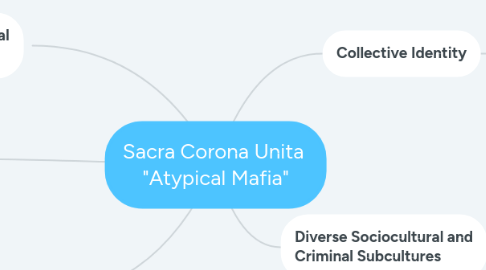
1. Alliances
1.1. The 'Ndrangheta
1.1.1. Collaboration in Criminal Activities
1.1.1.1. Drug trafficking
1.1.1.2. Weapons smuggling
1.1.1.3. Human smuggling
1.1.2. "Intellectual Collective" (Apollonio 2014)
1.1.2.1. Sharing of knowledge and experience
1.2. International Alliances with Counterparts
1.2.1. Albania
1.2.2. Romania
1.2.3. Russia
1.2.4. Slavs
2. "Federation"
2.1. Individual clans with high degree of autonomy
2.1.1. E.g. Clans located in the Salento and Bari areas
2.1.2. From time to time, but not necessarily, interact according to some agreement of reciprocal benefit (Mantovano 2001 cited in Apollonio 2014) e.g. Informative and logistic interchange
3. Loose Horizontal Hierarchical Structure
3.1. Hierarchical - Levels of Power
3.1.1. Società Minore (Lowest Level/ Minor)
3.1.1.1. Responsible for street work
3.1.1.2. High turnover
3.1.2. Società Maggiore (Second Level/ Major)
3.1.2.1. Lo Sgarro
3.1.2.1.1. Earned once a member has killed 3 people for SCU
3.1.2.1.2. Able to form a branch/ clan
3.1.2.1.3. Members with this rank who try to leave SCU are killed
3.1.2.2. La Santa
3.1.2.2.1. Rank is conferred by capos of a superior grade
3.1.2.2.2. Members are given gun, poison pill to commit suicide (symbols/ tools of loyalty)
3.1.3. Società Segreta (Highest Level/ Secret)
3.1.3.1. General council of decision makers
3.1.3.2. Group leaders in specific local areas inside which a series of capo-mafia operated
3.1.3.2.1. Brindisi unit
3.1.3.2.2. Unit south of Bari
3.1.3.2.3. Unit within Salento
3.1.3.3. Current leadership made up of second generation leaders
3.1.3.3.1. Sons/ relatives of previous leaders who have been mostly incarcerated
3.2. Formal Recruitment
3.2.1. Referred by an existing member
3.2.2. 40 day probation
3.2.3. Initiation rites, oath
4. Collective Identity
4.1. Source
4.1.1. Assimilated / borrowed culture from the 'Ndrangheta
4.1.2. References to past leaders, mythological creatures or historical personages (power and legitimacy)
4.2. Ritual and Symbolic Apparatus
4.2.1. Rules
4.2.1.1. Charter/ Constitution
4.2.1.2. Rintagli
4.2.1.2.1. Special formulas
4.2.1.3. Code words/ expressions
4.2.1.4. Code of conduct / sanctions
4.2.2. Ceremonies
4.2.3. Collective Oaths
4.2.3.1. Reference to ranks
4.2.4. Symbols of recognition
4.2.4.1. Rank based
4.2.4.2. Tattoos on different parts of the body
4.2.4.3. Incisions on the skin
4.2.5. Symbolic Objects
4.2.5.1. Armatura
4.2.5.1.1. Pin used to make incisions
4.2.5.2. Saint Michael
4.2.5.2.1. Common to both SCU and he 'Ndrangheta
4.2.5.3. White Silk Handkerchief
4.2.5.3.1. Represents purity of the soul
4.2.5.4. Spartenza
4.2.5.4.1. Share goods e.g. shared cigarettes during rituals
4.2.5.5. Lemon
4.2.5.5.1. Represents healing of the wounds of comrades
4.2.5.6. Ball of cotton
4.2.5.6.1. Represents Mont Blanc (holy place)
4.3. Common Interests
4.3.1. Prison
4.3.2. Shared Illegal Activities
4.4. Bonding Mechanisms for Secrecy and Loyalty
4.4.1. Poison Pill
4.4.1.1. Means to commit suicide
4.4.2. Gun
4.4.2.1. Represents punish members in case of betrayal
4.4.3. Increasing complexity of ceremonies at each hierarchy
4.4.3.1. Highest rank requires oaths of "absolute bonds of loyalty" to each other
4.4.4. Lower ranks do not know the identity of those at the top
4.4.5. Killing and burning of victims as a symbolic signal ("burned like this sacred image")
